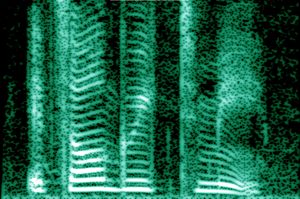Sound
In physics, sound is any phenomenon that involves the propagation of mechanical waves through a medium (fluid or solid) with a frequency within the range audible to humans (between 20 and 20,000 hertz). Above that frequency range are ultrasound, and below that are infrasound.
Sound consists of sound waves and acoustic waves produced when oscillations in air pressure are converted into mechanical waves in the human ear and perceived by the brain. Sound propagation is similar in fluids, where sound takes the form of pressure fluctuations. In solid bodies sound propagation involves variations in the stress state of the medium.
The propagation of sound involves energy transport without matter transport, in the form of mechanical waves that propagate through a solid, liquid or gaseous elastic medium. Among the most common are air and water. Sound, sound waves, do not propagate in a vacuum, unlike electromagnetic waves. If the vibrations occur in the same direction in which the sound propagates, it is a longitudinal wave and if the vibrations are perpendicular to the direction of propagation, it is a transverse wave.
Acoustic phonetics is especially interested in speech sounds: how they are generated, how they are perceived, and how they can be described graphically or quantitatively.
Physics of sound
The physics of sound is studied by acoustics, which deals with both the propagation of sound waves in different types of continuous media and the interaction of these sound waves with physical bodies.
Sound propagation
Certain characteristics of fluids and solids influence the sound wave. That is why sound travels faster in solids and liquids than in gases. In general, the higher the compressibility (1/K) of the medium, the lower the speed of sound. Density is also an important factor in the speed of propagation, in general the lower the density (ρ), other things being equal, the lower the speed of sound propagation. The speed of sound (v) is related to these magnitudes by the formula:
v=Kρ ρ {displaystyle v={sqrt {frac {K}{rho }}}}
In gases, temperature influences both compressibility and density, in such a way that a very important factor is the temperature of the propagation medium.
The propagation of sound is subject to some conditions. Thus, the transmission of sound requires the existence of a material medium where the vibration of the molecules is perceived as a sound wave. In the propagation in compressible media such as air, the propagation implies that in some areas the air molecules vibrate together (compression areas) and in other areas they move away (rarefaction areas), this alteration of distances between the molecules of air is what produces the sound. In highly incompressible fluids such as liquids, distances are very little affected but it manifests itself in the form of pressure waves. The speed of propagation of sound waves in a medium depends on the average distance between the particles of said medium, therefore, it is generally greater in solids than in liquids and in these, in turn, than in gases. No sound can propagate in a vacuum, so note that the explosions are therefore not really audible in outer space.
Sound waves are produced when a body vibrates rapidly. The frequency is the number of complete vibrations or oscillations that they make per second. The sounds produced are audible to an average human if the oscillation frequency is between 20 and 20,000 hertz. Above this last frequency you have ultrasound that is not audible to humans, although some animals can hear ultrasound that is inaudible to humans. The intensity of a sound is related to the square of the pressure amplitude of the sound wave. A low sound corresponds to a sound wave with a low frequency while high-pitched sounds correspond to higher frequencies.
Physical magnitudes of sound
Like all wave motion, sound can be represented by the Fourier transform as a sum of sinusoidal curves, pure tones, with an amplitude factor, which can be characterized by the same magnitudes and units of measurement as any wave. Well-defined frequency: Wavelength (λ), frequency (f) or inverse of period (T), amplitude (related to volume and acoustic power), and phase. This decomposition simplifies the study of complex sounds since it allows studying each frequency component independently and combining the results by applying the superposition principle, which is true because the alteration caused by a tone does not significantly modify the properties of the medium.
The characterization of an arbitrarily complex sound involves analyzing:
- Acoustic power: The level of acoustic power is the amount of radiated energy to the medium in the form of waves per unit of time by a given source. The unit in which it is measured is the watt and its symbol is W. Acoustic power depends on the amplitude.
- Frequency spectrum: the distribution of such energy among the various component waves.
Speed of sound
- In the air, the sound has a speed of 331.5 m/s when: the temperature is 0 °C, the atmospheric pressure is 1 atm (the sea level) and there is a relative humidity of the air of 0 % (dry air). Although it depends very little on air pressure.
- The speed of sound depends on the type of material it spreads. When the sound moves into the solids it has greater speed than in the liquids, and in the liquids it is faster than in the gases. This is because the particles in the solids are closer.
The speed of sound in air (V8) can be calculated in relation to temperature as follows:
Vs=V0+β β T{displaystyle V_{s}=V_{0}+beta T,}
Where:
- V0=331,3m/s{displaystyle V_{0}=331,3 {mbox{m/s}}{,}
- β β =0,606m/(s C){displaystyle beta =0,606 {mbox{m/(s}}{circ }{mbox{C)}}}}}
- T[chuckles] C]{displaystyle T [{}{circ }{mbox{C}}}}}It's temperature in Celsius degrees.
If the ambient temperature is 15 °C, the propagation speed of sound is 340 m/s (1224 km/h). This value corresponds to 1 MACH.
The speed of sound in water (at 25 °C) is 1593 m/s. The velocity in wood is 3700 m/s, in concrete it is 4000 m/s, and in steel it is 6100 m/s.
Reverberation
Reverberation is the sum total of the reflections of sound that reach the place of the receiver in different moments of time. Aurally it is characterized by an extension, like a "sound tail", which is added to the original sound. The duration and timbral coloration of this tail depend of: The distance between the listener and the sound source; the nature of sound-reflecting surfaces. In natural situations we speak of direct sound to refer to the sound that is transmitted directly from the sound source to us (or to the pickup mechanism we have). On the other hand, the reflected sound is the one that we perceive after it has bounced off the surfaces that delimit the acoustic enclosure, or on the objects that are in its trajectory. Obviously, the trajectory of the reflected sound will always be longer than that of the direct sound, so that -temporarily- we hear the direct sound first, and a few moments later we will hear the first reflections; As time goes by, the reflections that reach us are less and less intense, until they disappear. Our sensation, however, is not that of hearing separate sounds, since the brain integrates them into a single precept, as long as the reflections arrive less than 50 milliseconds apart. This is what is called the Haas effect or precedence effect.
Resonance
It is the phenomenon that occurs when two bodies have the same vibration frequency, one of which begins to vibrate upon receiving the sound waves emitted by the other.
To understand the phenomenon of resonance there is a very simple example. Suppose there is a tube with water and very close to it (without coming into contact) we have a tuning fork, if we hit the tuning fork with a piece of metal, while they pour water into the tube, when the water reaches a certain height the sound will be louder; This is due to the fact that the column of water contained in the tube begins to vibrate with the same frequency as that of the tuning fork, which shows why the frequencies are reinforced and consequently the intensity of the sound increases.
An example is the effect of tuning the strings of the guitar, since when tuning, what is done is equalize the frequencies, that is to say, put the sound of the strings in resonance.
Physiology of sound
Hearing aid
Sounds are perceived through the auditory apparatus that receives the sound waves, which are converted into movements of the otic osteocytes and perceived in the inner ear, which in turn transmits them through the nervous system to the brain. This ability is had even before birth.
Human voice
The human voice is produced by the vibration of the vocal cords, which generates a sound wave that is a combination of various frequencies and their corresponding harmonics. The oral-nasal cavity serves to create quasi-stationary waves, which is why certain frequencies called formants appear. Each speech sound segment is characterized by a certain frequency spectrum or distribution of sound energy at different frequencies. The human ear is capable of identifying different formants of said sound and perceiving each sound with different formants as qualitatively different, that is what allows, for example, to distinguish two vowels. Typically the first, lowest frequency formant is related to the vowel gap which is ultimately related to the frequency of the vertically vibrating standing waves in the cavity. The second formant is related to vibration in the horizontal direction and is related to whether the vowel is front, middle, or back.
The male voice has a fundamental pitch between 100 and 200 hertz, while the female voice is higher pitched, typically between 150 and 300 hertz. Children's voices are even higher pitched. Without the filtering by resonance produced by the nasal cavity, our sound emissions would not have the necessary clarity to be audible. This filtering process is precisely what makes it possible to generate the various formants of each segmental unit of speech.
Speech Sounds
Human languages use recognizable homogeneous segments of a few tens of milliseconds in duration, which make up the sounds of speech, technically called phones. Linguistically, not all acoustic differences are relevant. For example, women and children generally have higher pitched tones, so all the sounds they produce have, on average, a fundamental frequency and higher and more intense harmonics.
Competent speakers of a language learn to "classify" different qualitatively similar sounds into feature-relevant equivalence classes. Those equivalence classes recognized by speakers are the mental constructs we call phonemes. Most natural languages have a few dozen distinctive phonemes, despite the fact that the acoustic variations of phones and sounds are enormous.
Sound in music
Sound, in combination with silence, is the raw material of music. In music, sounds are classified into categories such as: long and short, loud and weak, high and low, pleasant and unpleasant. Sound has always been present in the daily life of man. Throughout history, the human being has invented a series of rules to order it until building some kind of musical language.
Properties
The four basic qualities of sound are pitch, duration, intensity, and timbre or color.
| Quality | Feature | Rank |
|---|---|---|
| Height or tone | Frequency of wave | Agudo, medio, grave |
| Duration | Vibration time | Long or short |
| Intensity | Wave width | Strong, weak or soft |
| Timbre | Wave or wave shape harmonics. Analogue to the texture | Depends on the characteristics of the source of sound (by analogy: rough, velvety, metallic, etc.) |
Height
The pitch, or pitch, indicates whether the sound is low, high, or medium, and is determined by the fundamental frequency of sound waves, measured in cycles per second or hertz (Hz).
- slow vibration = low frequency = serious sound.
- fast vibration = high frequency = sharp sound.
For humans to be able to perceive a sound, it must be between the hearing range of 20 and 20,000 Hz. Below this range we have infrasound and above it ultrasound. This is called the audible frequency range. As you get older, this range is reduced both in bass and treble.
In Western music, certain tones called notes were established, whose sequence of 12 (C, C#, D, D#, E, F, F#, G, G#, A, A#, B) is repeated forming octaves, in each of these the frequency is doubled. The difference between different notes is called an interval.
Duration
It is the time during which a sound is maintained. We can hear long, short, very short sounds, etc. The only acoustic instruments that can maintain sounds for as long as they want are those with bowed strings, such as the violin, and wind instruments (using circular or continuous breathing); but in general, wind instruments depend on lung capacity, and string instruments on the change in bow produced by the performer.
Sound takes between 12 and 15 hundredths of a second to reach the brain. In the event that the duration is shorter, there is no time for the height to be recognized, producing a clicking sensation called click.
Intensity
It is the amount of acoustic energy that a sound contains, that is, how loud or soft a sound is. The intensity is determined by the power, which in turn is determined by the amplitude and allows us to distinguish if the sound is strong or weak.
The intensity of sound is divided into physical intensity and auditory intensity, the first is determined by the amount of energy that propagates, in the unit of time, through the unit of area perpendicular to the direction in which it propagates the wave. And the auditory intensity that is based on the Weber-Fechner psychophysical law, which establishes a logarithmic relationship between the physical intensity of the sound that is captured, and the minimum physical intensity audible by the human ear.
The sounds we perceive must exceed the hearing threshold (0 dB) and not reach the pain threshold (130 dB). We measure this quality with a sound level meter and the results are expressed in decibels (dB) in honor of the scientist and inventor Alexander Graham Bell.
Intensity also has to do with directionality, as it is directly related to distance.
In musical notation, intensity is usually indicated with the following traditional terms, derived from Italian:
- fortissimo or very strong
- forte or strong
- mezzoforte or moderately strong
- or moderately mild
- piano or soft
- or very soft
Ringer
Timbre is the quality of sound that allows the identification of its sound source.
The same note sounds different if played by a flute, a violin, a trumpet, etc. Each instrument has a timbre that identifies it or differentiates it from the others. The quality of the material used to emit the sound also influences the variation of the timbre. The same thing happens with the voice. The sound emitted by a man, a woman, a child have different timbre. The timbre makes it possible to distinguish whether the voice is rough, sweet, hoarse or velvety. Thus, the sound will be clear, dull, pleasant or annoying. Timbre is a characteristic of sound that allows us to differentiate between two sounds that have the same tone, the same duration and the same sound intensity depending on the sound source. The timbre is a component of a sound that is given by the quantity and intensity of the different harmonics that compose it, as well as the shape of the sound wave, and specifically the amplitude envelope.
Sound fonts
Sound is a type of longitudinal mechanical waves produced by pressure variations in the medium. These pressure variations (captured by the human ear) produce the perception of sound in the brain.
Sounds generated by different sources exist in nature and their characteristics of frequency (height), intensity (strength), waveform (timbre) and envelope (modulation) make them different and unmistakable, for example, the soft running of water from a faucet has the same frequency, timbre, and envelope characteristics as the deafening rush of water at Iguazú Falls, with its approximately 100-meter free-fall height, but the intensity (always measured in decibels at one meter distance from the crash zone) is much greater.
Of the requirements indicated, the envelope is the most significant, since it is "the variation of the intensity during a time, generally the initial one, considered", the example of the difference in envelopes is the clear perception that we have when some scraped string instrument (violin, cello) are played "normally" with the bow rubbing the strings or when they are plucked (pizzicato); while in the first case the sound has approximately the same intensity throughout its performance, in the second case the sound starts with a maximum intensity (the taut string released by the musician) quickly attenuating over time and exponentially, so that the oscillation following the previous one follows a law of downward variation. Among the instruments that exhibit a constant envelope we have primarily the pipe organ (and its electronic copies), the saxophone (also air, like the organ) and those instruments that, not being with a fixed envelope, can easily control this function, such as the flute (recorder and harmonica), the tuba, the clarinet and the trumpets, the fife and whistles, horns of means of transport (warning instruments); Among the exponentially declining instruments we have all the percussion instruments that make up the "batteries": bass drums, cymbals, snare drums, tumbadoras (in this field we must highlight the cymbals, with a long decline time that can be violently cut by the musician) through a pedal or even the hand.
The perception of sound
Humans and other animals perceive sound through the sense of hearing, but we can also perceive low-frequency sounds through other parts of the body. Sounds audible to the human ear are generally considered to be those with a frequency between 20 and 20,000 Hz, but these limits are not clearly defined (for example, in the lower band there are those who consider lower values such as 12 Hz), and it is well known that the upper limit decreases with age. Above and below this range are ultrasound and infrasound, respectively. Other animal species can perceive other frequency ranges: the domestic cat 100-32,000 Hz; the African elephant 16-12,000 Hz; the bat 1,000-150,000 Hz or rodents 70-150,000 Hz. The example of dogs (40-46,000 Hz) is well known, which can hear sounds at frequencies above 20,000 Hz that are imperceptible to humans (there are whistles that emit ultrasounds that are used both to train and to scare dogs, but some think that it can also be used to disperse groups of young people).
For many animals the sense of hearing is essential for their survival, since they use sounds to detect danger, predation by detecting prey or for communication. Most of the phenomena that occur on Earth have associated characteristic sounds: rain, waves, fire, wind, etc. Many species, both mammals, amphibians such as frogs or birds, have developed special organs for the production of sounds, which in the case of some birds have evolved into singing or even human speech. Humans have even developed a culture and a technology based on the generation and transmission of sounds (culture of oral transmission, telephone, radio, phonograph, compact disc, etc...).
For the measurement of sound, a logarithmic scale is used, which allows us to represent very large and very small magnitudes with relatively small numbers, and which is a dimensionless figure because it is a relationship between two magnitudes with the same dimensions, the sound pressure with respect to an arbitrary reference sound pressure which, by international agreement, is 2 micropascals. This is the decibeliois scale, which expresses the magnitude of sound in decibels, one tenth of a bel, a rarely used unit. The origin of the scale, the value 0, corresponds to the human hearing threshold (2 μPa), so that the negative values would correspond to sounds imperceptible by man. The decibel is not a unit included in the International System of Units (there are scientists who do not consider it a unit), yet it is accepted to be used together with the SI units.
Sound pressure level
The level of sound pressure or sound level Lp{displaystyle L_{p}} is a logarithmic measure of the effective sound pressure of a mechanical wave regarding a reference source. It is measured in decibels:
- Lp=10log10 (pp0)2=20log10 (pp0)dB{displaystyle L_{mathrm {p} }=10log _{10}left({frac {p}{p_{p}}}}}}right)^{2}=20log _{10}left({frac {p}{p_{p}{p}}{right){mbox{ dB}}}}}}}}
where p0 is the reference sound pressure (the air is used to consider p0=20{displaystyle p_{0}=20} μPa, and p is the value of the effective pressure we want to measure.
If the propagation medium is air, the sound pressure level (SPL) is almost always expressed in decibels with respect to the reference pressure of 20 μPa, generally considered the threshold of audibility for humans (approximately equivalent to the sound pressure produced by a mosquito flying three meters away). Audio equipment measurements are almost always made in reference to this value. However, in other media, such as water, a reference pressure equal to μPa is often used. In general, it is necessary to know the reference level when comparing SPL measurements and the fact that often the unit dB (*SPL) being abbreviated as dB can be misleading, since it is a relative measure.
Examples of sound pressure levels
Considering the range of human perception (from 20 µPa to 20,000 Pa) in the decibel scale, perceptible sounds are between 0 and 180 decibels (dB)- The following table shows some examples:
| Decibels | Pressure (Pa) | Example |
|---|---|---|
| 180 | 20.000 | Missiles |
| 160 | 2,000 | Space rocket launch |
| 150 | 630 | Nuclear explosion |
| 140 | 200 | Airplane |
| 130 | 63 | Volcanic eruption, cannon |
| 120 | 20 | Pneumatic hammer, rock concert |
| 110 | 6.3 | Discoteca, hurricane |
| 100 | 2 | Storm strong, car horn |
| 90 | 0.63 | Storm, scooter with silencer |
| 80 | 0.2 | Olead |
| 70 | 0.063 | Rain |
| 60 | 0.02 | Normal conversation |
| 50 | 0.0063 | Llovizna |
| 40 | 0.002 | Talk low |
| 30 | 0,00063 | Cuchicheo |
| 20 | 0.0002 | Movement of leaves |
| 10 | 0.000063 | Night in the field, computer |
| 0 | 0,00002 | Hearing threshold |
Sound intensity level
Sound intensity level or sound intensity level ("LY ")is a logarithmic measure of sound intensity (measured in W/m²) compared to a reference value (10-12 W/m²). The relationship is defined as:
- LI=10log10 (I1I0)dB{displaystyle L_{mathrm {I} }=10log _{10}left({frac {I_{1}}{I_{0}}}}right)mathrm {dB} ,}
where Y1 is the sound intensity in W/m², and Y0 is the value of reference, which corresponds to the lowest sound intensity audible by the human ear at a frequency of 1,000 Hz. The sound intensity level is a dimensionless value and is expressed in decibels (dB).
On the other hand, if instead of taking the threshold intensity at 1,000 Hz, we take the real threshold intensity for each frequency then we would talk about loudness and it would be expressed in phons, the unit of measurement of the intensity of the sound sensation for the human ear.
The sensation that a sound produces in us is subjective and depends on the observer, There is no proportional relationship between the physical intensity of a sound and the sound sensation or loudness that it produces in us, the sound sensation approximately follows the Weber-Fechner law, which tells us that the sound sensation follows an arithmetic progression while the sound stimulus follows a geometric progression.
Noise pollution
noise pollution or noise pollution is the name given to the excess of sound that alters the normal conditions of the environment in a given area. Although noise does not accumulate, move or last over time like other pollution, it can also cause great damage to people's quality of life if it is not well or adequately controlled.
The term "acoustic pollution" refers to noise (understood as excessive and annoying sound), caused by human activities (traffic, industries, entertainment venues, planes, ships, among others) that produce negative effects on health hearing, physical and mental of living beings.
This term is closely related to noise because it occurs when noise is considered a pollutant, that is, an annoying sound that can produce harmful physiological effects such as decreased hearing capacity or deafness, and psychological effects. for a person or group of people.
The World Health Organization (WHO) considers 70 dB (A) as the desirable upper limit. Different countries have health regulations on acceptable limits both in the social environment and in the work environment, as well as measures to reduce noise pollution.
Contenido relacionado
Einstein field equations
Electric conductivity
Black hole












![T [{}^circmbox{C}]](https://wikimedia.org/api/rest_v1/media/math/render/svg/3b7bb012d6c8b32132aff99c3881370a0ce57320)






